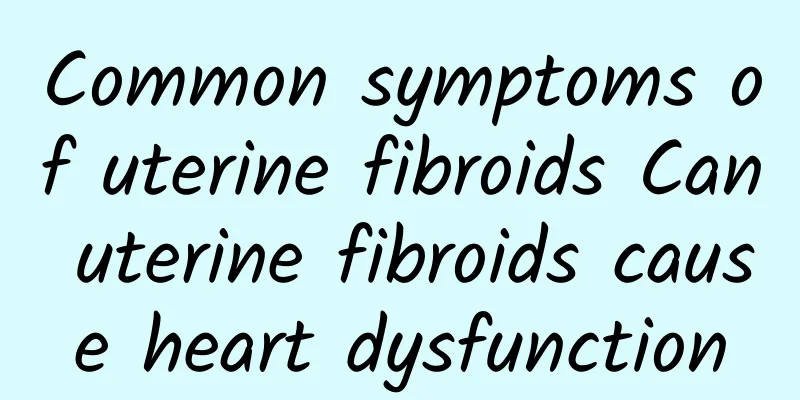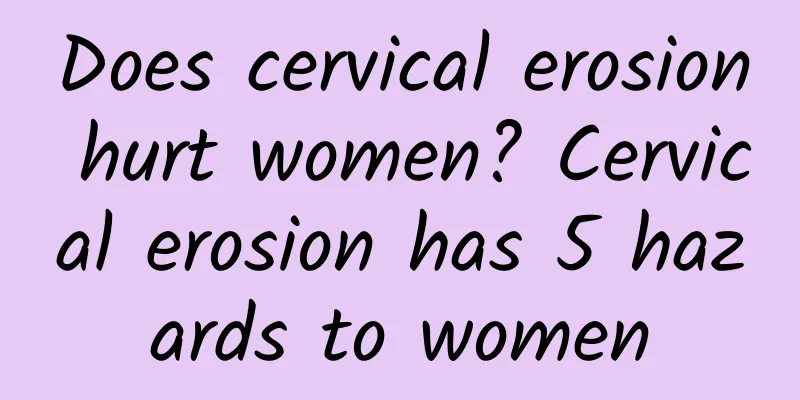Common symptoms of uterine fibroids Can uterine fibroids cause heart dysfunction

|
What are the symptoms of uterine fibroids? Introduction to uterine fibroids: Uterine fibroids (uterinemyoma) are the most common benign tumors in the female reproductive organs and one of the most common tumors in the human body. Uterine fibroids are mainly formed by the proliferation of uterine smooth muscle cells. A small amount of connective tissue fibers only exist as supporting tissue. Therefore, uterine fibroids cannot be called (fibromyoma), myofibroma or fibroma based on the number of connective tissue fibers. Its exact name is uterine leiomyoma (uterineleiomyoma), commonly known as uterine fibroids. The clinical manifestations of uterine fibroids often vary with uterine bleeding, abdominal mass, pain, compression symptoms of adjacent organs, increased leucorrhea, infertility, anemia and heart dysfunction. However, there are also many asymptomatic patients. 1. Uterine bleeding is the main symptom of uterine fibroids, occurring in half or more of the patients. Among them, cyclical bleeding (excessive menstruation, prolonged menstruation or shortened menstrual cycle) accounts for about 2/3; non-cyclical (continuous or irregular) bleeding accounts for 1/3. Bleeding is mainly caused by intramural fibroids and submucosal fibroids. Cyclic bleeding often occurs in intramural fibroids, while submucosal fibroids often present as irregular bleeding. Subserosal fibroids rarely cause uterine bleeding. In some cases, the menstrual volume decreases. What are the symptoms of uterine fibroids? The reasons for heavy bleeding from fibroids: ① Due to high estrogen levels, fibroid patients often have endometrial hyperplasia and polyps, leading to excessive menstruation; ② The uterus increases in size, the endometrial area increases, and bleeding is excessive and prolonged. Especially in the case of submucosal fibroids, the mucosal bleeding area can reach more than 225cm2 (normal is about 15cm2); ③ Submucosal fibroids, the mucosal surface often ulcerates and necroses, leading to chronic endometritis, leading to dripping bleeding; ④ Intramural fibroids affect uterine contraction and clamp vascular function, or the endometrium of submucosal fibroids is peeled off and cannot contract, resulting in increased bleeding and prolonged duration; ⑤ Large fibroids can be combined with pelvic congestion, making the blood flow vigorous and large; ⑥ Menstrual irregularities during menopause. Excessive or prolonged menstruation may occur alone or in combination. If present with shortened menstrual cycles (frequent menstruation), a large amount of blood may be lost in a short period of time, resulting in severe anemia. Submucosal fibroids may separate from the vagina, causing non-cyclic bleeding, which may be heavy. Large polyp fibroids also often cause continuous bleeding. 2. Abdominal mass Lower abdominal mass is usually the main complaint of patients with uterine fibroids, up to 69.6%. Sometimes it may be the only symptom of fibroids. Intramural fibroids that grow into the abdominal cavity and do not affect the endometrium, especially those located at the bottom of the uterus or with pedicles, often have this situation. Abdominal masses are often found after uterine fibroids grow out of the pelvic cavity, and are often obvious in the early morning when the bladder is full on an empty stomach. Because the uterus and fibroids are pushed upward, it is easy for patients to touch them by themselves. If the uterus is larger than 4 to 5 months of pregnancy, it can also be touched when the bladder is not full. Uterine fibroids are generally located in the middle of the lower abdomen, and a few may be located on one side of the lower abdomen, with a hard texture or a sense of unevenness. Larger ones are more likely to be degenerated, softer and smoother. Most of them grow slowly. According to the data from the early days of liberation, some patients who had grown for 22 years before seeking medical treatment were mainly due to the oppression of working women in the old society and the lack of conditions for medical treatment. Very few may grow faster or be accompanied by dull pain, and malignant changes should be suspected. 3. Pain accounts for about 40% of patients with abdominal pain, 25% of patients with backache and 45% of patients with dysmenorrhea; there is also lower abdominal swelling or back pain, which is not very serious. The pain is caused by tumor compression of pelvic blood vessels, blood stasis, nerve compression or submucosal fibroids, which can stimulate uterine contraction, and the cervical canal is discharged from inside and outside the uterine cavity and widens and causes pain; or fibroid necrosis infection caused by pelvic inflammatory disease, adhesions, traction, etc. If the uterine fibroids are red and degenerated, the abdominal pain will be severe and accompanied by fever. Torsion or axial torsion of the pedicle of subserosal uterine fibroids can also cause acute and severe abdominal pain. Large subserosal fibroids grow in wide ligaments, which not only compress nerves and blood vessels to cause pain, but also compress the ureters to cause ureteral or renal pelvic hydrops and cause low back pain. Severe and progressive dysmenorrhea is often caused by uterine fibroids complicated by adenomyosis or endometriosis. 4. Compression symptoms mainly occur in cervical fibroids, or are caused by the enlargement of fibroids in the lower part of the uterus, filling the pelvic cavity and surrounding organs. When the bladder is compressed, frequent urination or dysuria, urinary retention, etc. will occur; compression of the ureter will cause hydronephrosis and pyelitis. Fibroids growing on the posterior wall of the uterus can compress the rectum, causing constipation and even difficulty in defecation. Pelvic venous pressure can cause edema of the lower limbs. Compression symptoms are more obvious in the early stages of menstruation, which is the reason for the congestion and swelling of uterine fibroids. If subserosal fibroids are embedded in the uterine rectal fossa, bladder or rectal compression symptoms may also occur. About 30% of fibroids cause compression symptoms, of which frequent urination accounts for 20%, dysuria accounts for about 10%, urinary retention accounts for 3%, urinary retention accounts for 5%, dysuria accounts for 5%, constipation accounts for 20%, and lower limb edema accounts for 6%. 5. Leucorrhea Leucorrhea increases by 41%. 9%. Enlarged uterine cavity, increased endometrial glands, pelvic congestion or inflammation can increase leucorrhea; when submucosal fibroids ulcerate, become infected, bleed, or become necrotic, a large amount of bloody or purulent leucorrhea will be produced. 6. Infertility and miscarriage 30% of patients with uterine fibroids are infertile. Infertility may be due to medical reasons, such as uterine fibroids being found during examination. There are many reasons for infertility due to uterine fibroids. Please refer to the special section on uterine fibroids and pregnancy. The spontaneous abortion rate is higher than that of normal people, with a ratio of 4:1. 7. Anemia Anemia can occur in patients with long-term bleeding but not treated in time. Before liberation, most working women had persistent uterine bleeding due to the urgency of life, but could not be treated, leading to anemia. In the early days of liberation, a document on patients with uterine fibroids introduced: 45.25% of patients had 5-10 grams of hemoglobin, 12.4% had hemoglobin below 5 grams, and most of them were submucosal fibroids. Severe anemia (below 5 grams) can lead to anemic heart disease and myocardial degenerative changes. 8. Hypertension Some patients with uterine fibroids have hypertension. According to statistics, most hypertensive patients (except those with a history of hypertension) return to normal after the removal of fibroids, which may be related to the release of ureteral compression. 9. Physical signs Myoma is less than 3 months old, and the pregnant uterus is large, which is generally not easy to touch through the abdomen. Those that can be touched are generally in the middle of the lower abdomen, hard and uneven. In patients with thin abdominal walls, the outline of the tumor can be clearly touched, and even its shape can be seen. Gynecological double clinics can generally clearly touch the outline of uterine fibroids. The anterior or posterior wall of the uterus is protruding; multiple fibroids can touch multiple smooth, hard spherical masses; lumps protruding from the side wall of the uterus to one side may be broad ligament fibroids; the cervix is obviously enlarged and the normal uterus can be touched, indicating cervical fibroids; the uterus is obviously and uniformly enlarged and hard, which may be a submucosal fibroid hidden in the uterus or cervical canal. If the cervix is relaxed, a smooth spherical tumor can often be touched by inserting a finger; some are exposed at the cervical opening and even enter the vagina, which can be clearly seen at a glance; but some are secondary to infection, necrosis, or are larger, and the cervix cannot be touched, which is easily confused with cervical malignant tumors, uterine inversion, etc. What are the symptoms of uterine fibroids? The location of fibroid growth can also affect the position of the uterine body and cervix. For example, fibroids on the posterior wall of the uterus can push the uterine body and cervix forward; if fibroids on the posterior wall of the uterus develop toward the rectouterine fossa, they can even squeeze the uterus to the upper back of the pubic symphysis, and the outline of the uterus can be felt in the lower abdomen, and the cervix also moves upward, the posterior wall of the vagina bulges forward, and the cervix cannot be felt during vaginal examination; if it is a broad ligament fibroid, it often pushes the uterine body to the opposite side. Except for the change in the shape and size of the mass felt on palpation, the relationship of the fibroid to the uterine body and cervix remains the same. 10. Nutrition, anemia, heart function, urinary system status, etc. are related to the duration of the disease, amount of bleeding or other complications. |
<<: What are the symptoms of uterine fibroids? How to self-examine uterine fibroids?
Recommend
What are the dangers of premature menopause in women
Premature menopause in women is mostly caused by ...
How long does it usually take to cure pelvic inflammatory disease? Considering many factors
Pelvic inflammatory disease is a very common gyne...
What treatments are most effective for cervical warts?
Many skin and sexually transmitted diseases appea...
Why is vaginal candidiasis difficult to cure?
The reason why candidal vaginitis is difficult to...
What diseases can easily be confused with perimenopausal dysfunctional uterine bleeding?
In clinical work, it is not easy to accurately di...
Don’t touch these three fattening breakfasts! Avoid eating too much and gaining weight
"Breakfast is an important source of calorie...
Why do women still suffer from adnexitis without sexual life?
Many female friends would like to know the reason...
What are the uncomfortable symptoms of cervical erosion
Cervical erosion is a common gynecological diseas...
Kill two birds with one stone Oxford: Regular breastfeeding after childbirth helps weight loss
The government has recently been vigorously promo...
Can I get painkillers for dysmenorrhea?
You can get painkillers when you have dysmenorrhe...
What infections can cause chronic cervicitis?
Experts say that the cause of chronic cervicitis ...
What are the reasons for missed menstruation? What issues should be paid attention to?
What are the reasons for delayed menstruation? 1....
Egg white can cure cervical erosion
After suffering from cervical erosion, in additio...
Sugary soy milk, black soy milk, and salty soy milk, which one has the highest calories? Nutritionist: Drinking the wrong soy milk will increase your weight instead of reducing it
Breakfast is the most important meal to start the...
How to stop bacterial vaginosis from recurring
Bacterial vaginosis is caused by a mixed infectio...









